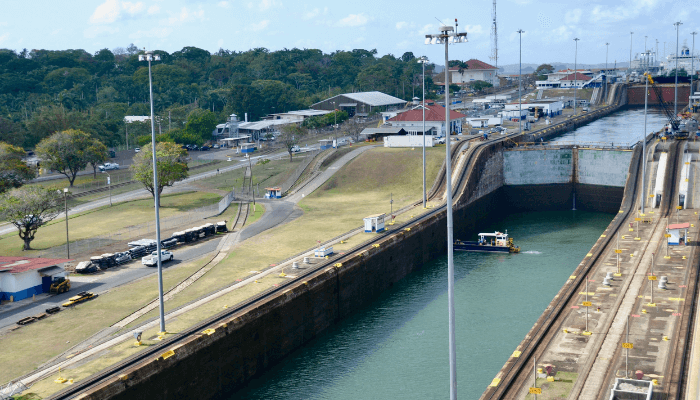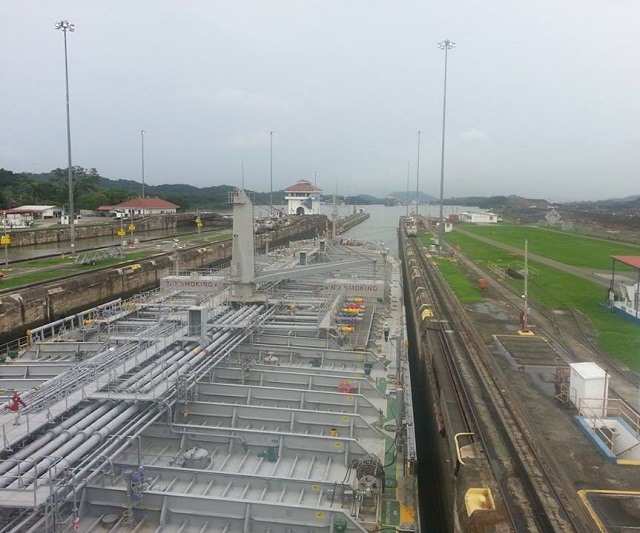

The 48-mile-long (77 km) international waterway known as the Panama Canal allows vessels to pass between the Atlantic Ocean and the Pacific Ocean, saving about 8000 miles (12,875 km) from a journey around the southern tip of South America, Cape Horn. Interestingly, it lies at latitude 9 degree north, where the North American Continental divide goes down to one of its lowest points.
The canal construction created a dam which led to the formation of the Gatun lake on the northern part of the isthmus.
Read: Do you know about these critical Panama Canal Facts?
The idea of creating a canal over the isthmus of Panama goes back to the 15th century. One of the first countries to attempt construction was France. The team was led by Count Ferdinand de Lesseps, the builder of the Suez Canal in Egypt. Although they planned for a sea-level canal in the 1880s, they faced many challenges, such as the spread of yellow fever and malaria. De Lesseps realized that the task was difficult and decided on a lock canal. However, they had insufficient funds.
After understanding the riches of Peru, Ecuador, and Asia and evaluating the time it took the gold to reach the ports of Spain, it was suggested in 1524 to Charles V, the King of Spain, that cutting out a piece of land somewhere in Panama, the trips would be made shorter and the danger of taking the treasures through the cape would rationalize such an enterprise. A survey of the isthmus was ordered, and an operational plan for a canal was subsequently drawn up in 1529. The European wars and the thirst for controlling kingdoms in the Mediterranean Sea put the project on permanent hold.


In 1534 a Spanish bureaucrat suggested a canal route close to that of the now-present canal & shortly abandoned its interest in the channel.
Various surveys between 1850 and 1875 showed that only two routes were practical, one across Panama and another across Nicaragua. In 1876 an international company was organized; two years later, it obtained a concession from the Colombian government to dig a canal transversely to the cape.
In 1899, the US Congress created an Isthmian Canal Commission to observe the potential of a Central American canal and to advise a route. The commission first decided on a path through Nicaragua but later reversed its verdict. The Lesseps Company offered its assets to the United States for $40 million.
President Theodore Roosevelt and the new state of Panama signed the Hay-Bunau-Varilla treaty, by which the United States guaranteed the liberty of Panama and secured a continuous lease on a 10-mile strip for the canal. Panama was to be compensated by an early payment of $10 million and an annuity of $250,000, beginning in 1913. This strip is now known as the Panama Canal Zone.
The construction of a lock canal was decided in 1906. The first three years expanded construction facilities, surveys, and disease control. The structure of locks began in August 1909. They were built in pairs; each lock chamber measured 110 ft breadthwise and was 1000 ft long. They were embedded with culverts that allowed gravity to raise and lower the water level. Finally, the locks lifted the ships to a height of 85 ft above sea level and put them on the other side.
The canal was opened on August 15, 1914, and formal dedication took place on July 12, 1920. The cost was $336,650,000, and 240 million cubic metres of earth were vacated.


In 1939, treaty amendments increased Panama’s annuity to $434,000, provided for a transisthmian highway, and abrogated the US. Guarantee of the impartiality and autonomy of Panama. Although in the same year, Congress authorized the construction of the third set of locks, then World War II intervened, and the plans were shelved. In 1955 the income was raised to $1,930,000, and the United States undertook to build a high-level bridge over the Pacific side of the canal. The Gaillard Cut was widened in 1969 to permit two-way traffic.
In 1977, a treaty was signed by U.S. President Jimmy Carter and Panama leader Omar Torrijos, with the Panama Canal Authority taking complete control on December 31, 1999. It was also recognized as one of the seven wonders of the modern world by Civil Engineers.
Very few human endeavours have ever conceded to change the face of the planet on which we live, as did the successful completion of the inter-oceanic Panama Canal in 1914 by the United States.
If you liked this article, you might also want to read A brief history of the Suez Canal.
The Panama Canal is owned and administered by the Republic of Panama since the management rights were transferred from the joint US-Panamanian Panama Canal Commission in 1999.
The Panama Canal project altered maritime trade, commerce and travel. It decreased the transit time from the east coast to the western coast of America by half. It was a technological marvel and even the American Society of Civil Engineers called it one of the seven wonders of the modern world.
The Panama Canal has helped to reduce Greenhouse Gas Emissions on our planet aby enabling more efficient maritime transportation of goods. It also saves fossil fuels by reducing fuel consumption per cargo unit.
The construction of the Panama Canal was difficult, challenging and equally dangerous. Most labourers were poor and hailed from Barbados, Maritinique, Guadeloupe. About 25,000 workers lost their lives during the construction of the canal.










We believe that knowledge is power, and we’re committed to empowering our readers with the information and resources they need to succeed in the merchant navy industry.
Whether you’re looking for advice on career planning, news and analysis, or just want to connect with other aspiring merchant navy applicants, The Marine Learners is the place to be.